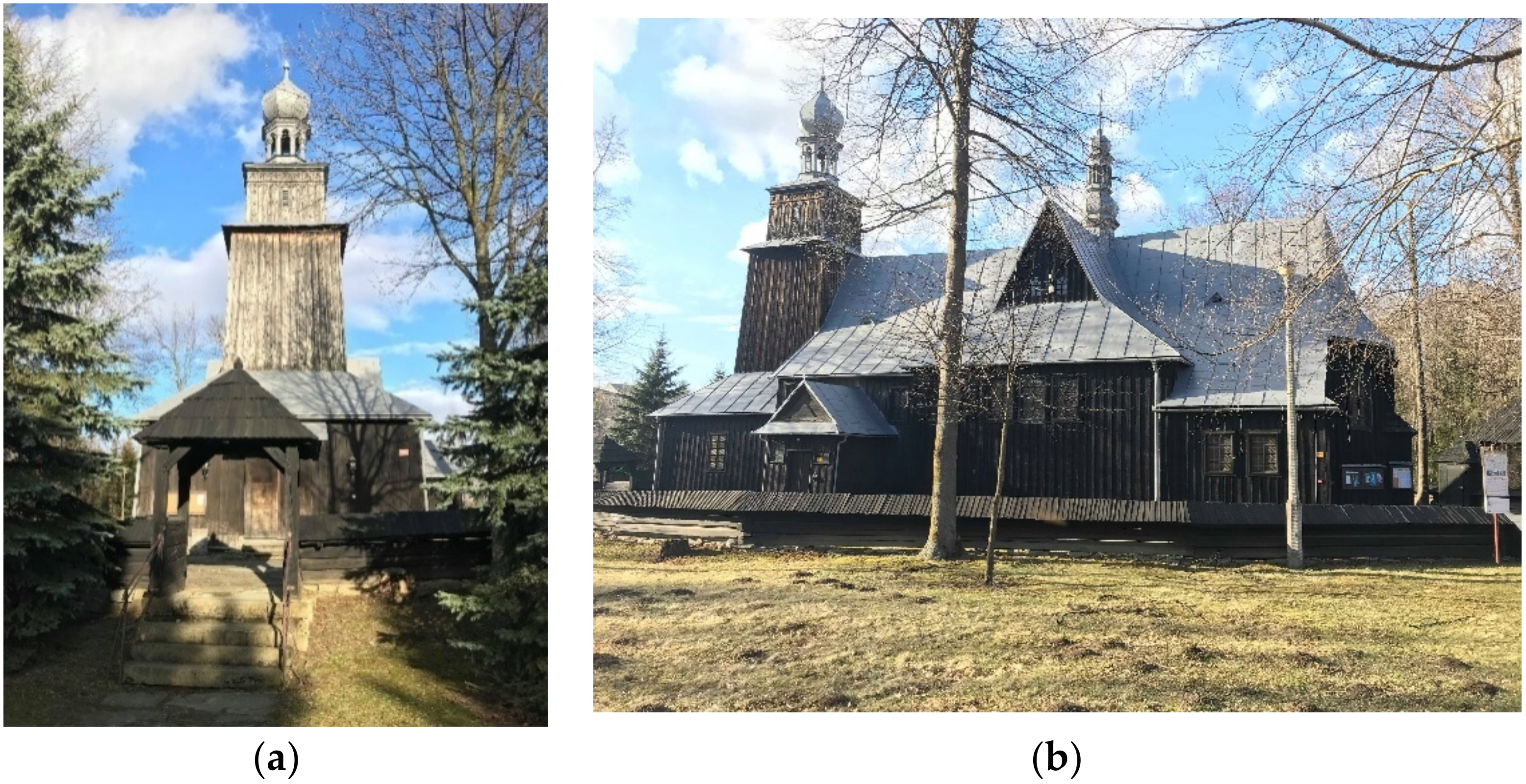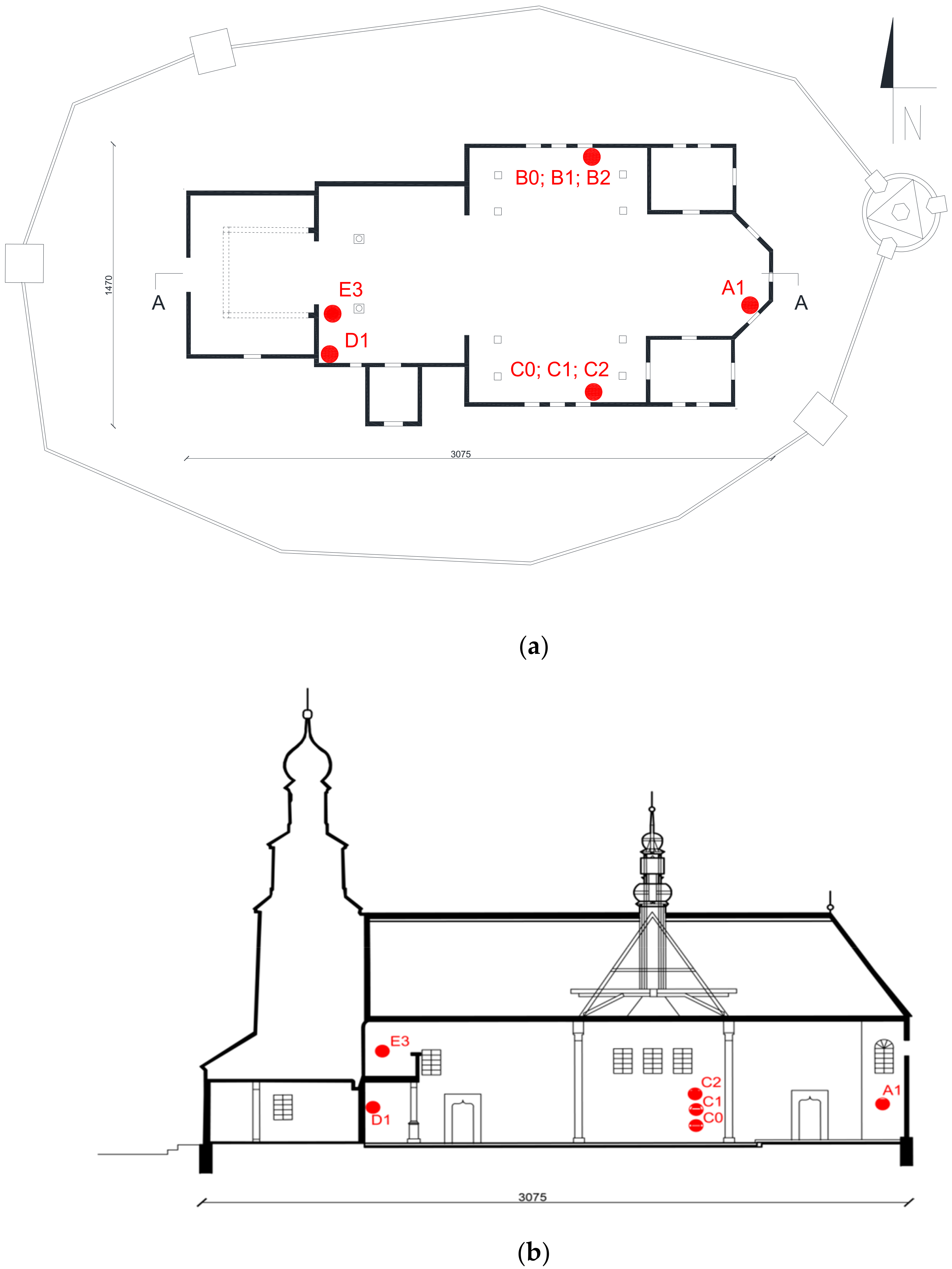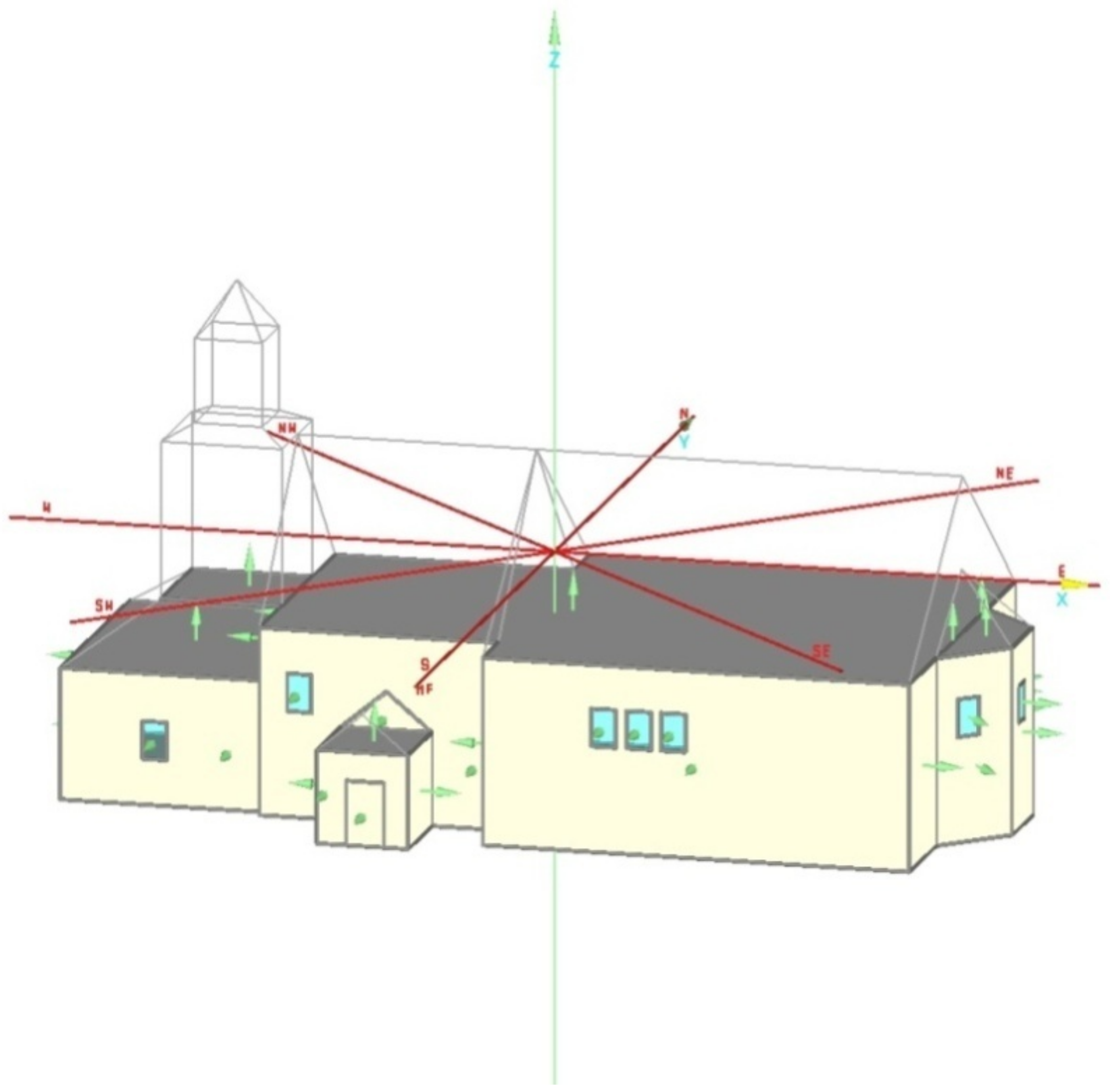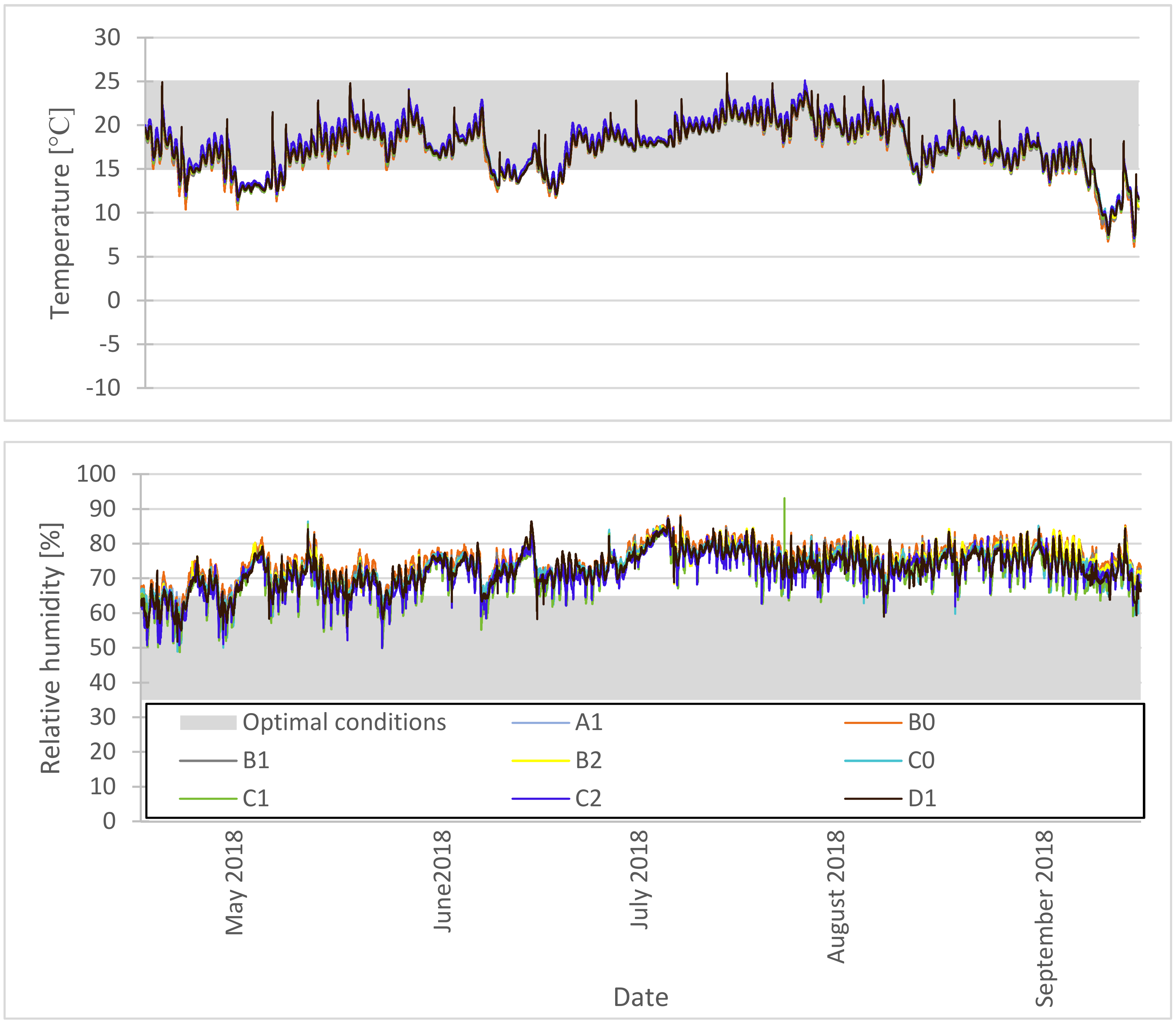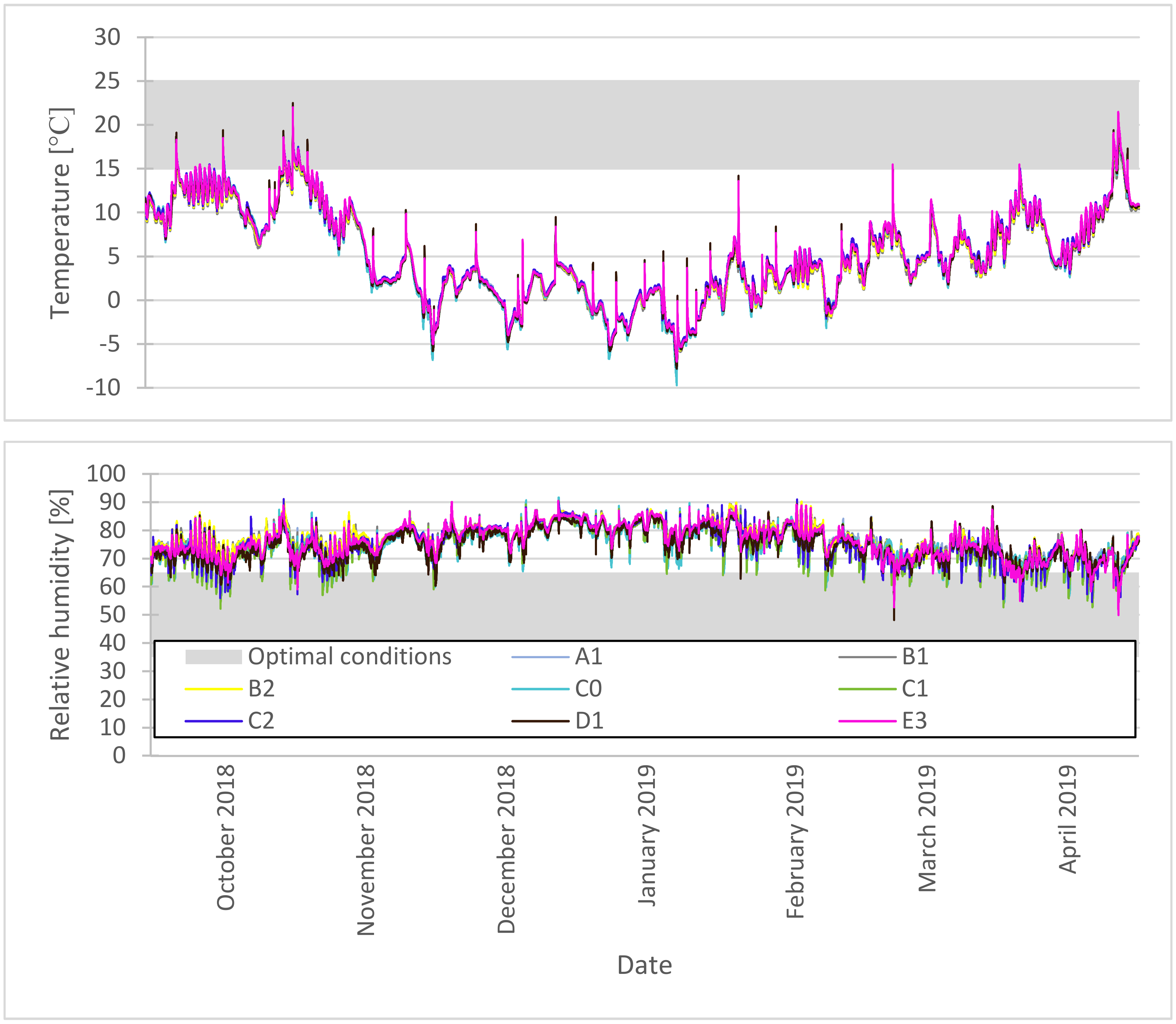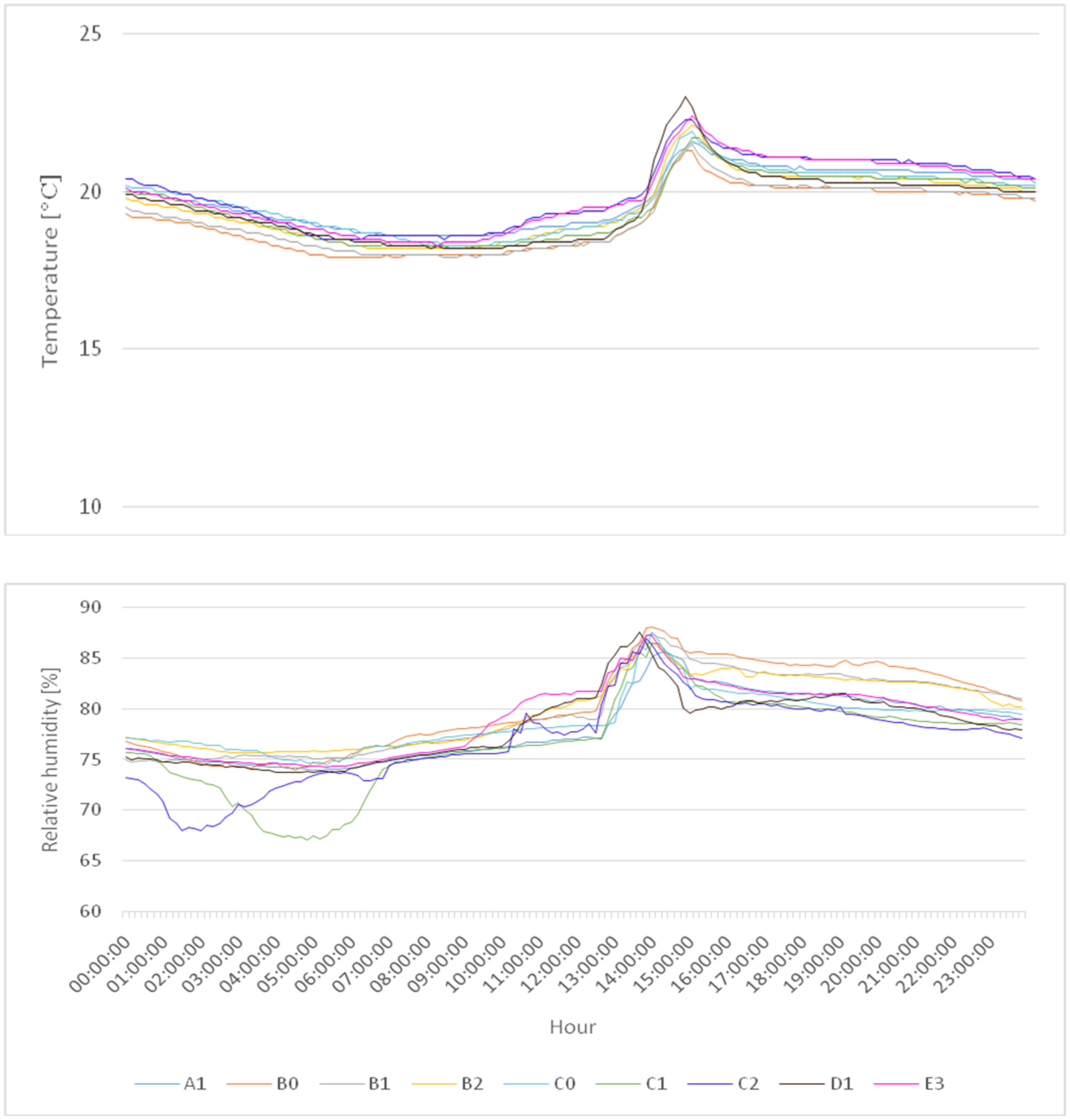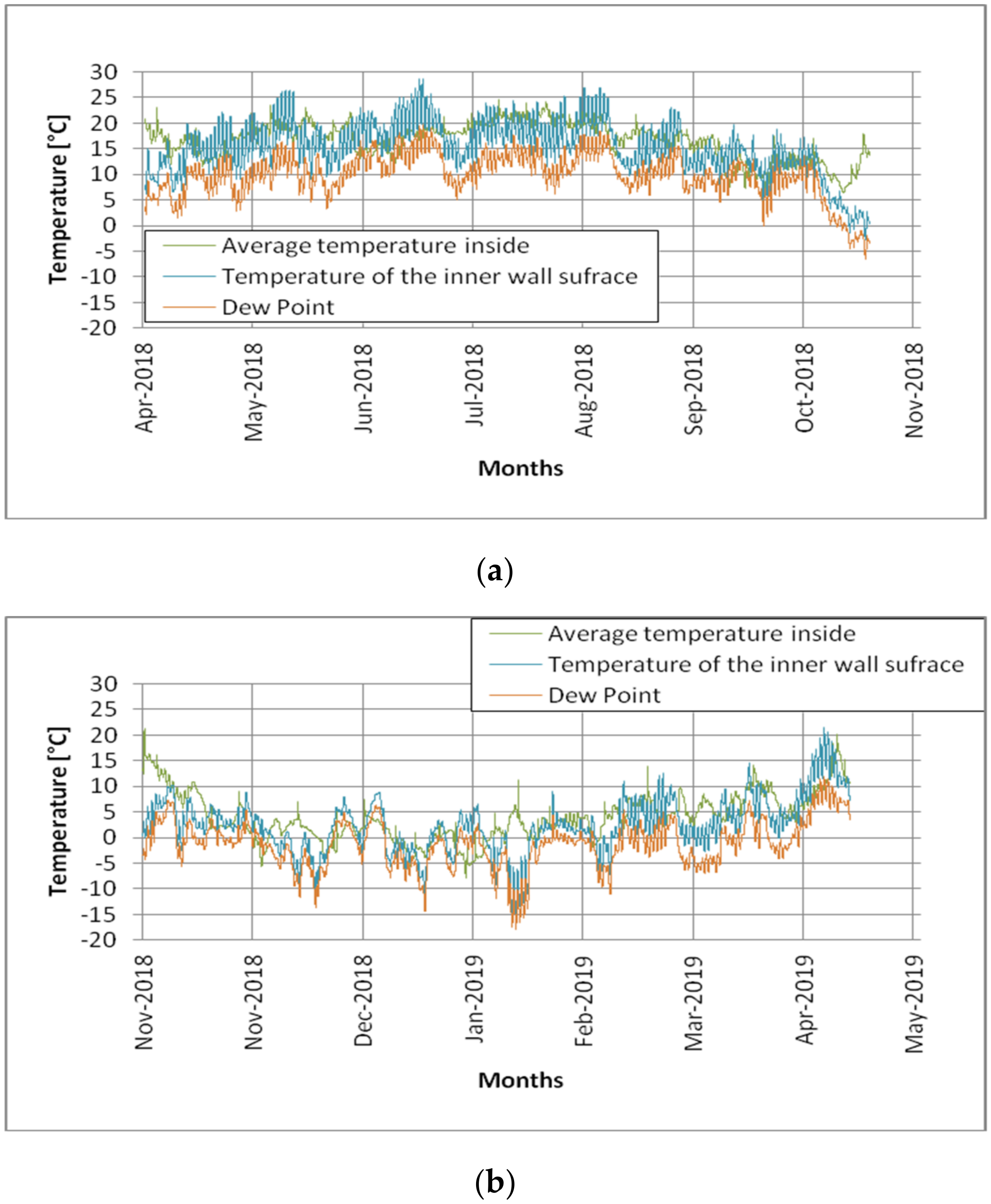1. Introduction
Because they are a source of knowledge about the historical architecture of the world and particular regions, churches are an essential part of culture. Many of them contain valuable monuments, starting from their architectural plan (which is evidence of structural and aesthetical trends in a given period), as well as other components such as polychromes on the walls and vaults, altars, sculptures, paintings, floors, and organs, among many other features. The deterioration of such objects constitutes an irreversible loss of a piece of cultural heritage. The most important factor that allows us to keep the aforementioned artefacts in good condition is an appropriate microclimate. The specific functions performed by historic buildings determine the instability and inequality of the number of people inside them. The thermal and humidity conditions inside a church are mainly influenced by the variability of the outdoor conditions, the cubic volume of the church, the material and structural solutions in the building envelope, and the heating and ventilation systems. In their studies, Wolski and Jelec [
1] pointed out that zones of differentiated thermal and humidity conditions can be distinguished in churches. It should also be noted that many historic wooden churches in Poland are unheated or are heated cyclically.
Brataszand Kozłowski [
2], in their studies at the Church of Santa Maria Maddalena Rocca Pietore, investigating the response of wooden sculptured parts to temperature and relative humidity changes, concluded that temperature changes rapidly affect all materials in a structure, while the response of wooden objects to relative humidity changes is much slower. Each painted wooden object with its individual original structure and conservation history is acclimatized to the environment it has been exposed to. Such objects need individual levels of temperature and relative humidity. Scientific studies, however, have indicated that 50 ± 15% relative humidity fluctuations are safe [
3].Rapid changes in the temperature and relative humidity of the indoor air can lead to the deterioration of polychromes, sculptures, and even the structure of a church.
Studies by Camuffo et al. [
4] indicated that church heating can cause problems—periodic relative humidity drops cause the drying and shrinkage of objects with low thermal inertia. In unheated churches, the dominant problem is mold, which is mainly caused by moisture. The risk of mold occurrence is much lower in heated churches than in unheated ones [
5]. The modernization of historic buildings with collections should take not only the requirements of the collection but also possible conflicts with the thermal comfort of people and the hazards related to the structural materials into account [
6]. In various ways, heating systems satisfy certain needs in terms of the conservation of church interiors and the thermal comfort of the people inside. However, thermal comfort and the preservation of monuments have different microclimate requirements [
7].
Interest in historic buildings is growing. The goals of studying historic buildings are varied, but the most popular aim is to improve the energy efficiency and thermal comfort in historic buildings [
8]. In their studies, Sempriniet al. [
9] focused on the reuse of an ancient church as an exhibition hall or an auditorium. Church microclimates, inter alia, were also studied by Silva et al. [
10] in a monastery in Lisbon, by Wach and Miczyński [
11] in a church in Dębno Podhalańskie, and by Varas-Muriel et al. [
12] in a church in Madrid. An analysis of the existing literature showed that researchers mainly deal with objects inside historic buildings in which the microclimate of the interior is controlled. However, there are many historic buildings that are unheated, where the microclimate of the interior is not monitored. Rapid fluctuations in the temperature and relative humidity of the air can have a destructive effect on the antique polychromes and works of the art inside.
Numerical models are increasingly used in interior microclimate studies of buildings [
13,
14,
15]. In the case of unheated objects without active systems, it is not possible to counteract the occurrence of adverse hygrothermal conditions. In the case of historic buildings, this can lead to irreparable damage to paintings, sculptures, polychromes, and other valuable elements inside the building [
13]. Numerical methods can be used, among others, for anon-stationary analysis of the variability of selected physical parameters, such as humidity and temperature, as well as for estimating the biological risk in the event of condensation [
16,
17,
18]. There are numerous simulation tools for modeling supportive solutions. Building energy simulation (BES) can be performed using more than 200 calculation tools. The modeling of historical buildings is a particularly difficult area. This is very important for ensuring the continuity of test results that are used later in the validation of computational models. Generating a building model often requires the integration of straight and curved surfaces into a series of flat surfaces to meet software requirements. In addition, compounds such as rainwater pollution, wind, and other atmospheric processes that are heavily dependent on the model are also included. It is very important to become familiar with the technical parameters of the partitions and their humidity, because these factor shave a significant impact on conclusions. In modeling assumptions, it is extremely difficult to combine ventilation and infiltration in a building that is heterogeneous and variable overtime. For tall buildings (over 3 m), a vertical temperature gradient should also be considered [
19].
In this paper, the authors chose a non-heated wooden church in which services are held several times a year. The purpose of the research was to determine the temperature and humidity conditions prevailing in the church, including those at which there may be a threat to the exhibits and the possible destruction of the wooden structure of the church.
3. Results
3.1. Experimental Research
The results of the outdoor and indoor temperature and relative humidity measurements are presented in
Figure 5 and
Figure 6. In the period of study, the warmest month was August (average air temperature of 19 °C), and the coldest month was January (average air temperature of −4.1 °C).The outdoor temperature had a huge impact on the indoor temperature and relative humidity.
Due to differentiated thermal and humidity conditions, the period of studies was divided into two subperiods: summer and winter. The analysis was carried out for nine measuring points located inside the church.
Figure 7 and
Figure 8 show the indoor air temperature, relative humidity, and the limit values of optimum indoor thermal and humidity conditions. The ranges of analyzed parameters that are optimal for such buildings are 20 ± 5 °C for temperature and 50 ± 15% for relative humidity [
3,
20]. Other microclimate researchers of sacral objects have already adopted such values.
Throughout 84 days of the summer period, the indoor air humidity exceeded the limit (65%) and reached 85%. The elevated relative humidity inside the church might have been caused by poor ventilation and the absence of damp-proofing on the floor and foundations.
In the winter period, the indoor air temperature stayed below 15 °C, and in January, it even fell below −9 °C. It reached optimum values several times on individual days in October, November, and April. The increased temperature was related to the services held in the church at that time. The indoor relative humidity in the winter period was above the required value for the larger part of that period. Its maximum values exceeded 90%.
As a result of the specific use of the church (services held a few times a year), momentary fluctuations of air temperature and relative humidity could be observed. The results are shown in
Figure 9 and
Figure 10.
Table 1 summarizes the number of people present at the services.
Figure 9 presents the air temperature and relative humidity values on 22 July 2018. On this day, one service was held that was attended by about 160 people. The air temperature during the day before the service was from 17.9 to 20.7 °C, while the relative humidity was from 67.1% to 81.6%. The appearance of people at the service increased the air temperature by 5.3 °C under the church choir. This was due to the fact that the faithful gather most often in this part of the building. At the point located in the choir, the temperature increased to 3.1 °C. The vertical temperature stratification was therefore 2.2 °C. At its peak, the relative humidity was 85.6% and occurred in the boundary zone of the north wall of the church.
In the winter, a day was selected for detailed analysis when there were about 400 people at the service (
Figure 10). Before the service, the church’s air temperature was around −5 °C, while during the service, it rose to 4.8 °C. The analysis of relative humidity showed a very large fluctuation of this parameter during the service. The largest difference in air temperature, amounting to 9.4 °C, during the service was recorded under the choir, while the lowest, 5.2 °C, was noted in the nave and in the presbytery. Relative humidity fluctuations ranged from 7.1% (point E3) to 15% (point D1).
The impact of the number of people in the church on the interior microclimate was varied and depended on the season. The greatest fluctuations in temperature and relative humidity occurred in winter during services. These violent fluctuations in the interior microclimate could adversely affect the wooden antique elements of the church’s furnishings and its construction. One should agree with the statement of Bratasz and Kozlowski [
7] that each painted wooden object with an individual original structure is acclimated to the specific environment in which it was exposed. Such an object needs individual levels and ranges of air temperature and relative humidity. Rapid changes in these parameters can lead to the faster degradation of historic polychromes.
The detailed analysis of indoor air temperature and relative humidity during the services showed that these parameters depended mainly on the number of people attending the service.
3.2. Computational Analysis
The analysis of the obtained results, in reference to the optimum thermal and humidity conditions required for historic buildings, indicated that this church does not meet them for 230 days of the year. The favorable condition ensuring long-term protection is a stable microclimate. There are periodic relative humidity drops in this church (from above 80% to below 70%). Such fluctuations could be a cause of damage to both the wood and the paintings. The relative humidity in the analyzed period was above 70%, meaning that it exceeded the threshold value, whose upper limit was assumed at 65%. The air temperature in such a building should be in the 20 ± 5 °C range. Such conditions were met in the summer period, but in the winter period, the air temperature in the church was considerably below 15 °C. The temperature differences during the services were from 2.9 to 9.5 °C. Taking into account the comfort conditions for the participants of the service, particularly in winter when people wear outer garments in the church, the air temperature should be 12–16 °C. In the analyzed winter period, the temperature was below 10 °C and even dropped down to −9.7 °C, thus not meeting the thermal comfort conditions for the people inside the building.
An analysis of the calculation results showed no risk of condensation on the surface of the internal walls (
Figure 11). The smallest difference between the wall surface temperature and the dew point temperature for given conditions occurred during the winter at one of the services and was 1.6 °C. During the entire study period, the temperature of the inner wall surface was 4.5 °C higher, on average, compared to the dew point temperature. It should be noted, however, that the temperature of the internal surface of the partitions was unstable. During the year, the values of this parameter ranged from −8.0 to 24.6 °C.
The risk of condensation on the internal surfaces of the interior partitions was very strongly correlated with the number of people at the services. The largest number of worshippers in the church occurred on 1 November 2018 (496 people), but this did not cause the phenomenon of steam condensation on the partitions.
4. Discussion
During most of the study, the relative humidity in the building was above 75%. The studies by Maroy K. et al. [
20] in a Watervliet church also indicated the problem of excessive humidity. The authors of the studies assumed that 75% was the maximum relative humidity that prevented the biological degradation of wooden works of art. An excessive relative humidity (84–89%) in an unheated church was also recorded in a church in Estonia; the authors noted a high risk of mold. The conditions in the Estonian church maybe influenced by the close vicinity of the sea [
5,
21]; in the referred to paper, the maximum daily temperature change was 1.5 °C and the maximum relative humidity changes was 4%.The daily temperature differences in the studied church reached as much as 9 °C.
The studies indicated that despite the exceeded maximum indoor air temperature and relative humidity, there is no risk of vapor condensation on the building envelopes in the church in Ptaszkowa. The church has a thermally uninsulated and non-damp-proofed floor that significantly affects the thermal and humidity conditions inside.
Similarly to the church in Dębno Podhalańskie [
11], the average annual air temperature and relative humidity values depend mainly on outdoor conditions. The differences in the air temperature and relative humidity values between the studied church and the church in Dębno Podhalańskie maybe related to their use. The services in the church in Dębno Podhalańskie are held daily, and in the studied church, they are only held only a few times a year. The relationship between the indoor and the outdoor conditions was also noted in a church in Madrid [
12]. The problem of maintaining optimum conditions also occurred in a church in Milan [
22]. The authors’ studies have shown that wooden historic sacral objects should be heated in winter. The conducted research showed that the number of the faithful at services also had a significant impact on the development of thermal and humidity conditions in an unheated wooden church. These types of objects tolerate sudden changes in temperature and relative humidity very badly. The influence of people in the church on increasing the biological risk due to exceeding the contractual limit of 75% relative humidity was observed. The presence of the faithful was not found to affect the condensation of water vapor in the same way. In order to obtain future results, the authors plan to use computational tools such as Computational Fluid Dynamics (CFD) and Energy Plus, which are some of the tools that are used in monitoring microclimate parameters, among others, in historical objects [
19].
5. Conclusions
The research conducted by the authors allowed for a thorough examination of the variability of selected parameters of the internal and external microclimate and their dependence, as well as the impact of people staying in the church on the formation of these parameters.
The average indoor air temperature was 10.5 °C, and the average indoor relative humidity was 74.6%. The extreme indoor air temperatures in the church were −9.7 °C (22 January 2019) and 25.9 °C (29 July 2018). The extreme relative humidity values were 48.2% (9 March 2019) and 91.6% (27 December 2018).
The amplitude of indoor air temperature fluctuations was 35.6 °C, and that of the indoor air relative humidity was 46%.
On the days when the services were not held, the air temperature and relative humidity inside the building were found to mainly depend on the outdoor conditions. The rise of temperature and relative humidity was noted during the services, and this was affected by the number of people in the church. The air temperature differentiation during the service was zone-dependent and ranged from 2.5 to 9.5 °C.The vertical temperature stratification between the zone under the choir, where the faithful gather most often, and the zone in the choir (at a height of 4.5 m)was also strongly noticeable. The temperature gradient in this case was from 2.5 to 3.7 °C.
The thermal and humidity conditions during the period of study exceeded the optimum values for historic buildings. The studied building has a thermally uninsulated and non-damp-proofed floor that significantly affects the thermal and humidity conditions inside.
The recorded cases of indoor temperature and relative humidity values in excess of the recommended values can result in the biological degradation of wooden works of art.
The studies have indicated that despite the exceeded maximum indoor air temperature and relative humidity, there is no risk of vapor condensation on the building inside walls in the church in Ptaszkowa. It should be noted, however, that the wall inside surface temperature was unstable, which may adversely affect the durability of polychromes and paintings and the building structure itself. In light of the above summary, the following conclusions can be drawn:
In the examined historic wooden church, despite the lack of faithful inside the building, there are periodic, automatic episodes of exceeding the relative humidity limit (75%) that may contribute to the occurrence of damage associated with paintings and polychromies.
Due to frequent and automatic exceeding of the relative humidity limit values, the ventilation of the tested object should be examined, including by the tracer gas dilution method.
The influence of people staying in the church on the changing temperature and relative humidity of the air are important, but the presence of people in the building does not influence the occurrence of water vapor at the surface level of the partitions.
The occurrence of a vertical air temperature gradient from 2.5 to 3.7 °C occurs in the area under the choir (measuring point D1) and in the choir (measuring point E3).
